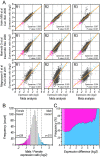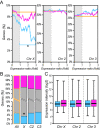Demasculinization of the Anopheles gambiae X chromosome
- PMID: 22607633
- PMCID: PMC3428665
- DOI: 10.1186/1471-2148-12-69
Demasculinization of the Anopheles gambiae X chromosome
Abstract
Background: In a number of organisms sex-biased genes are non-randomly distributed between autosomes and the shared sex chromosome X (or Z). Studies on Anopheles gambiae have produced conflicting results regarding the underrepresentation of male-biased genes on the X chromosome and it is unclear to what extent sexual antagonism, dosage compensation or X-inactivation in the male germline, the evolutionary forces that have been suggested to affect the chromosomal distribution of sex-biased genes, are operational in Anopheles.
Results: We performed a meta-analysis of sex-biased gene expression in Anopheles gambiae which provides evidence for a general underrepresentation of male-biased genes on the X-chromosome that increased in significance with the observed degree of sex-bias. A phylogenomic comparison between Drosophila melanogaster, Aedes aegypti and Culex quinquefasciatus also indicates that the Anopheles X chromosome strongly disfavours the evolutionary conservation of male-biased expression and that novel male-biased genes are more likely to arise on autosomes. Finally, we demonstrate experimentally that transgenes situated on the Anopheles gambiae X chromosome are transcriptionally silenced in the male germline.
Conclusion: The data presented here support the hypothesis that the observed demasculinization of the Anopheles X chromosome is driven by X-chromosome inactivation in the male germline and by sexual antagonism. The demasculinization appears to be the consequence of a loss of male-biased expression, rather than a failure in the establishment or the extinction of male-biased genes.
Figures





Similar articles
-
Little evidence for demasculinization of the Drosophila X chromosome among genes expressed in the male germline.Genome Biol Evol. 2012;4(10):1007-16. doi: 10.1093/gbe/evs077. Epub 2012 Sep 12. Genome Biol Evol. 2012. PMID: 22975718 Free PMC article.
-
Paucity of genes on the Drosophila X chromosome showing male-biased expression.Science. 2003 Jan 31;299(5607):697-700. doi: 10.1126/science.1079190. Epub 2003 Jan 2. Science. 2003. PMID: 12511656 Free PMC article.
-
Demasculinization of X chromosomes in the Drosophila genus.Nature. 2007 Nov 8;450(7167):238-41. doi: 10.1038/nature06330. Nature. 2007. PMID: 17994090 Free PMC article.
-
Gene content evolution on the X chromosome.Curr Opin Genet Dev. 2008 Dec;18(6):493-8. doi: 10.1016/j.gde.2008.09.006. Epub 2008 Oct 16. Curr Opin Genet Dev. 2008. PMID: 18929654 Free PMC article. Review.
-
X-Chromosome Dependent Differences in the Neuronal Molecular Signatures and Their Implications in Sleep Patterns.Sleep Med Clin. 2023 Dec;18(4):521-531. doi: 10.1016/j.jsmc.2023.06.014. Epub 2023 Aug 12. Sleep Med Clin. 2023. PMID: 38501524 Review.
Cited by
-
The Effect of Hybridization on Dosage Compensation in Member Species of the Anopheles gambiae Species Complex.Genome Biol Evol. 2018 Jul 1;10(7):1663-1672. doi: 10.1093/gbe/evy108. Genome Biol Evol. 2018. PMID: 29860336 Free PMC article.
-
A synthetic sex ratio distortion system for the control of the human malaria mosquito.Nat Commun. 2014 Jun 10;5:3977. doi: 10.1038/ncomms4977. Nat Commun. 2014. PMID: 24915045 Free PMC article.
-
Single-cell profiling of Anopheles gambiae spermatogenesis defines the onset of meiotic silencing and premeiotic overexpression of the X chromosome.Commun Biol. 2023 Aug 15;6(1):850. doi: 10.1038/s42003-023-05224-z. Commun Biol. 2023. PMID: 37582841 Free PMC article.
-
The Potential for a Released Autosomal X-Shredder Becoming a Driving-Y Chromosome and Invasively Suppressing Wild Populations of Malaria Mosquitoes.Front Bioeng Biotechnol. 2021 Dec 3;9:752253. doi: 10.3389/fbioe.2021.752253. eCollection 2021. Front Bioeng Biotechnol. 2021. PMID: 34957064 Free PMC article.
-
Comparative Transcriptomics of Malaria Mosquito Testes: Function, Evolution, and Linkage.G3 (Bethesda). 2017 Apr 3;7(4):1127-1136. doi: 10.1534/g3.117.040089. G3 (Bethesda). 2017. PMID: 28159865 Free PMC article.

